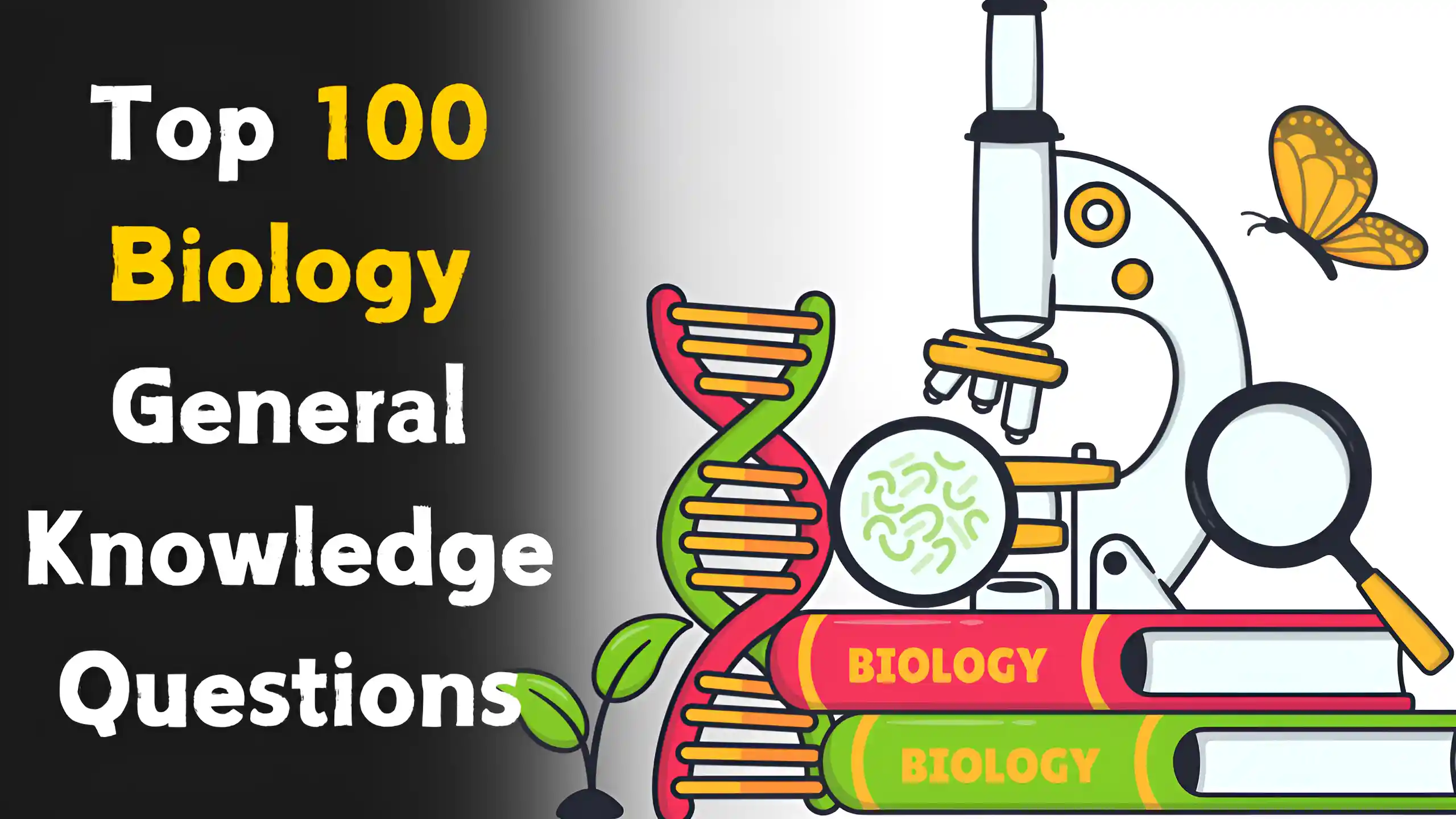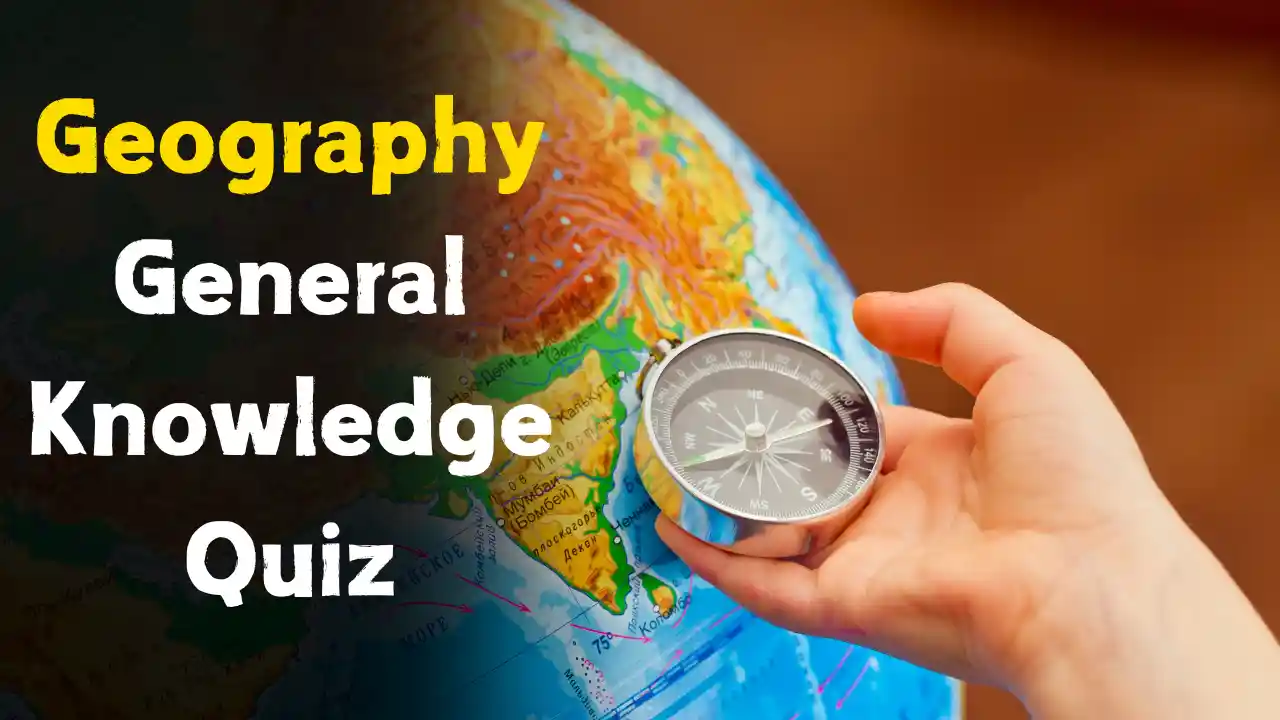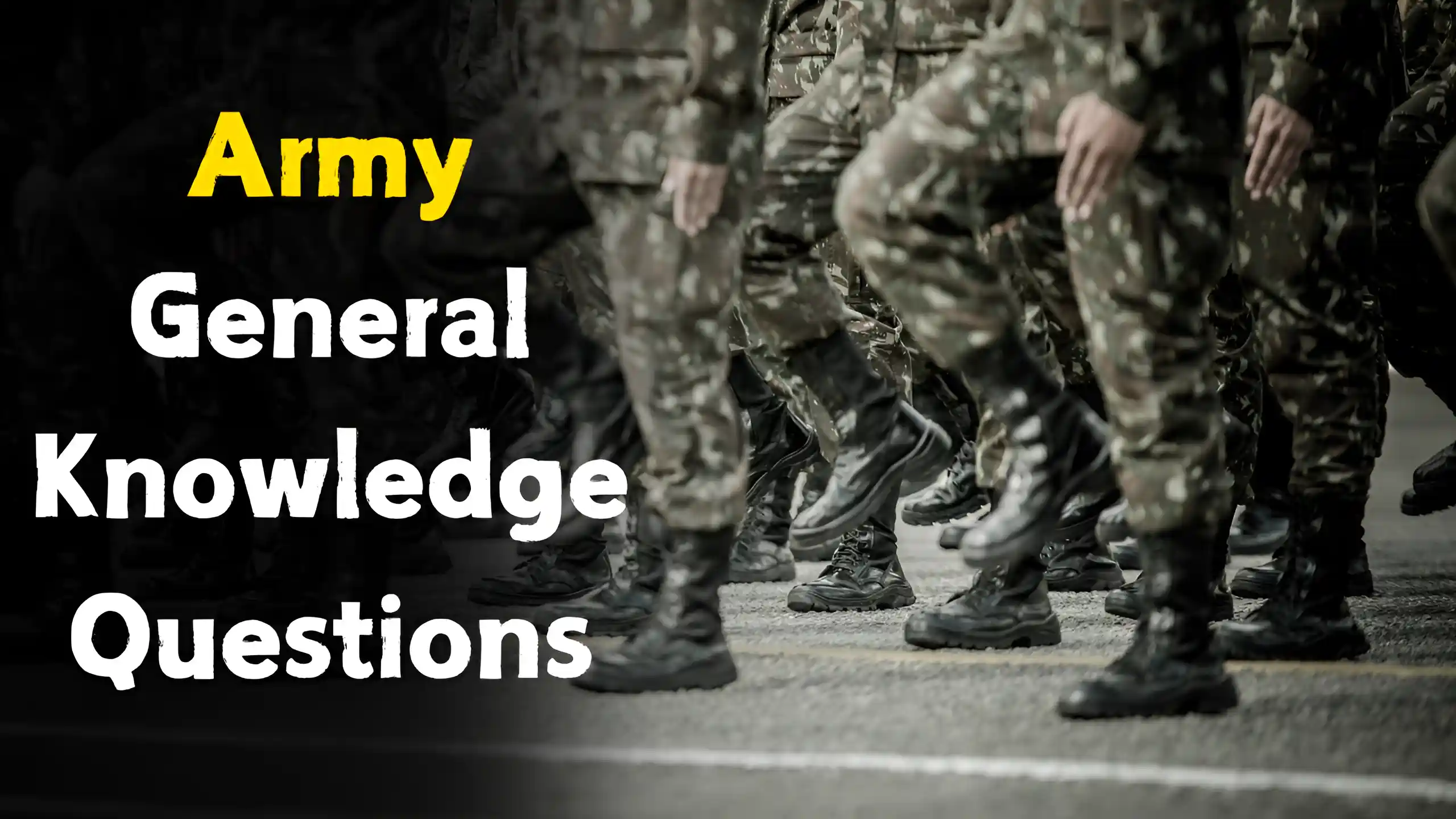Biology is the study of life and living organisms. It encompasses various aspects, from the structure and function of cells to the complex systems of the human body and ecosystems. This article provides 100 biology general knowledge questions and answers, perfect for students, quiz enthusiasts, and learners who want to enhance their understanding of the subject.
Biology General Knowledge Quiz
1. What is the basic unit of life?
a) Atom
b) Cell
c) Molecule
d) Tissue
Answer: Cell
2. Which organ in the human body is responsible for pumping blood?
a) Brain
b) Lungs
c) Heart
d) Liver
Answer: Heart
3. What is the powerhouse of the cell?
a) Nucleus
b) Ribosome
c) Mitochondria
d) Golgi apparatus
Answer: Mitochondria
4. What is the chemical formula for glucose?
a) H₂O
b) CO₂
c) C₆H₁₂O₆
d) O₂
Answer: C₆H₁₂O₆
5. Which is the largest organ in the human body?
a) Liver
b) Heart
c) Skin
d) Brain
Answer: Skin
6. What is the study of fungi called?
a) Botany
b) Mycology
c) Zoology
d) Ecology
Answer: Mycology
7. Which part of the plant is responsible for photosynthesis?
a) Roots
b) Stem
c) Leaves
d) Flowers
Answer: Leaves
8. What is the largest bone in the human body?
a) Tibia
b) Femur
c) Humerus
d) Radius
Answer: Femur
9. Which pigment gives plants their green color?
a) Chlorophyll
b) Hemoglobin
c) Melanin
d) Carotene
Answer: Chlorophyll
10. Which organ in the human body filters waste from the blood?
a) Liver
b) Kidney
c) Lungs
d) Heart
Answer: Kidney
11. What is the smallest unit of heredity?
a) DNA
b) Gene
c) Chromosome
d) RNA
Answer: Gene
12. Which blood cells help in clotting?
a) Red blood cells
b) White blood cells
c) Platelets
d) Plasma
Answer: Platelets
13. What is the process by which plants make food?
a) Respiration
b) Digestion
c) Photosynthesis
d) Fermentation
Answer: Photosynthesis
14. What is the normal pH level of human blood?
a) 6.5
b) 7.4
c) 8.0
d) 9.0
Answer: 7.4
15. Which enzyme breaks down proteins in the stomach?
a) Amylase
b) Lipase
c) Pepsin
d) Trypsin
Answer: Pepsin
16. What is the largest gland in the human body?
a) Pancreas
b) Thyroid
c) Liver
d) Adrenal
Answer: Liver
17. What is the main function of red blood cells?
a) Fight infections
b) Carry oxygen
c) Produce hormones
d) Transport nutrients
Answer: Carry oxygen
18. Which part of the brain controls balance and coordination?
a) Cerebrum
b) Cerebellum
c) Medulla oblongata
d) Hypothalamus
Answer: Cerebellum
19. Which vitamin is produced by the skin when exposed to sunlight?
a) Vitamin A
b) Vitamin C
c) Vitamin D
d) Vitamin E
Answer: Vitamin D
20. What is the process by which water moves across a semi-permeable membrane?
a) Diffusion
b) Osmosis
c) Filtration
d) Active transport
Answer: Osmosis
21. Which type of blood vessel carries blood away from the heart?
a) Arteries
b) Veins
c) Capillaries
d) Venules
Answer: Arteries
22. What is the main structural component of plant cell walls?
a) Cellulose
b) Starch
c) Protein
d) Lipids
Answer: Cellulose
23. Which part of the flower becomes the fruit?
a) Petal
b) Ovary
c) Stigma
d) Sepal
Answer: Ovary
24. Which hormone regulates blood sugar levels?
a) Insulin
b) Adrenaline
c) Thyroxine
d) Estrogen
Answer: Insulin
25. What is the scientific name for humans?
a) Homo erectus
b) Homo sapiens
c) Australopithecus
d) Neanderthal
Answer: Homo sapiens
26. Which organ in the human body is responsible for producing bile?
a) Liver
b) Pancreas
c) Stomach
d) Kidney
Answer: Liver
27. What is the main function of white blood cells?
a) Carry oxygen
b) Fight infections
c) Transport nutrients
d) Produce hormones
Answer: Fight infections
28. Which blood group is known as the universal donor?
a) AB+
b) O+
c) O-
d) AB-
Answer: O-
29. What is the study of birds called?
a) Ornithology
b) Ichthyology
c) Herpetology
d) Mammalogy
Answer: Ornithology
30. Which organelle is known as the “control center” of the cell?
a) Mitochondria
b) Nucleus
c) Ribosome
d) Golgi apparatus
Answer: Nucleus
31. What is the term for animals that eat both plants and animals?
a) Herbivores
b) Carnivores
c) Omnivores
d) Scavengers
Answer: Omnivores
32. Which part of the human eye is responsible for controlling the amount of light that enters?
a) Cornea
b) Retina
c) Iris
d) Lens
Answer: Iris
33. What is the largest artery in the human body?
a) Aorta
b) Pulmonary artery
c) Coronary artery
d) Carotid artery
Answer: Aorta
34. What is the term for the process by which cells divide?
a) Mitosis
b) Meiosis
c) Cytokinesis
d) Binary fission
Answer: Mitosis
35. Which vitamin helps in blood clotting?
a) Vitamin A
b) Vitamin C
c) Vitamin D
d) Vitamin K
Answer: Vitamin K
36. What are the smallest blood vessels in the body called?
a) Arteries
b) Veins
c) Capillaries
d) Venules
Answer: Capillaries
37. Which organ in plants absorbs water and minerals from the soil?
a) Roots
b) Stem
c) Leaves
d) Flowers
Answer: Roots
38. What is the structural and functional unit of the kidney?
a) Nephron
b) Glomerulus
c) Bowman’s capsule
d) Tubule
Answer: Nephron
39. Which part of the brain controls breathing and heartbeat?
a) Cerebellum
b) Medulla oblongata
c) Cerebrum
d) Hypothalamus
Answer: Medulla oblongata
40. What is the term for a plant that grows on another plant?
a) Parasite
b) Epiphyte
c) Saprophyte
d) Autotroph
Answer: Epiphyte
41. What is the main function of the large intestine?
a) Absorption of nutrients
b) Absorption of water
c) Digestion of proteins
d) Production of enzymes
Answer: Absorption of water
42. Which hormone is known as the “stress hormone”?
a) Insulin
b) Cortisol
c) Thyroxine
d) Adrenaline
Answer: Cortisol
43. What is the genetic material in most living organisms?
a) DNA
b) RNA
c) Proteins
d) Lipids
Answer: DNA
44. What type of reproduction involves only one parent?
a) Sexual reproduction
b) Asexual reproduction
c) Pollination
d) Fertilization
Answer: Asexual reproduction
45. Which part of the cell is responsible for protein synthesis?
a) Ribosomes
b) Lysosomes
c) Mitochondria
d) Vacuole
Answer: Ribosomes
46. Which disease is caused by a deficiency of Vitamin C?
a) Rickets
b) Scurvy
c) Night blindness
d) Beriberi
Answer: Scurvy
47. Which type of animal maintains a constant body temperature?
a) Ectothermic
b) Endothermic
c) Cold-blooded
d) Amphibians
Answer: Endothermic
48. What is the term for the fusion of male and female gametes?
a) Fertilization
b) Pollination
c) Reproduction
d) Germination
Answer: Fertilization
49. What is the function of the stomata in plants?
a) Photosynthesis
b) Transpiration
c) Respiration
d) All of the above
Answer: All of the above
50. Which part of the ear helps maintain balance?
a) Cochlea
b) Semicircular canals
c) Eardrum
d) Auditory nerve
Answer: Semicircular canals
51. Which process converts sugar into energy in cells?
a) Photosynthesis
b) Respiration
c) Fermentation
d) Transpiration
Answer: Respiration
52. What is the liquid part of blood called?
a) Plasma
b) Platelets
c) Red blood cells
d) White blood cells
Answer: Plasma
53. Which type of organism can make its own food?
a) Autotroph
b) Heterotroph
c) Parasite
d) Saprophyte
Answer: Autotroph
54. Which vitamin is known as the “sunshine vitamin”?
a) Vitamin A
b) Vitamin D
c) Vitamin C
d) Vitamin B
Answer: Vitamin D
55. What is the main function of the small intestine?
a) Absorption of nutrients
b) Absorption of water
c) Production of bile
d) Storage of waste
Answer: Absorption of nutrients
56. What are organisms that live in extreme environments called?
a) Extremophiles
b) Parasites
c) Autotrophs
d) Heterotrophs
Answer: Extremophiles
57. Which type of blood vessel carries blood to the heart?
a) Arteries
b) Veins
c) Capillaries
d) Aorta
Answer: Veins
58. Which gas is produced during photosynthesis?
a) Carbon dioxide
b) Oxygen
c) Nitrogen
d) Hydrogen
Answer: Oxygen
59. What is the scientific study of insects called?
a) Entomology
b) Ornithology
c) Ecology
d) Herpetology
Answer: Entomology
60. What is the largest muscle in the human body?
a) Gluteus maximus
b) Quadriceps
c) Biceps
d) Trapezius
Answer: Gluteus maximus
61. Which organelle is known as the “digestive system” of the cell?
a) Ribosome
b) Lysosome
c) Mitochondria
d) Golgi apparatus
Answer: Lysosome
62. Which disease is caused by a deficiency of iron?
a) Anemia
b) Rickets
c) Scurvy
d) Beriberi
Answer: Anemia
63. Which part of the brain controls hunger and thirst?
a) Hypothalamus
b) Cerebrum
c) Cerebellum
d) Medulla oblongata
Answer: Hypothalamus
64. What is the process by which plants lose water through their leaves?
a) Transpiration
b) Photosynthesis
c) Respiration
d) Fertilization
Answer: Transpiration
65. Which blood group is known as the universal recipient?
a) AB+
b) O-
c) A+
d) B+
Answer: AB+
66. What is the term for a group of similar cells performing the same function?
a) Tissue
b) Organ
c) System
d) Organism
Answer: Tissue
67. Which vitamin is necessary for good eyesight?
a) Vitamin A
b) Vitamin B
c) Vitamin C
d) Vitamin D
Answer: Vitamin A
68. Which organ produces insulin?
a) Pancreas
b) Liver
c) Stomach
d) Gallbladder
Answer: Pancreas
69. What is the term for animals that eat only plants?
a) Herbivores
b) Carnivores
c) Omnivores
d) Scavengers
Answer: Herbivores
70. Which part of the plant anchors it to the soil?
a) Stem
b) Leaves
c) Roots
d) Flowers
Answer: Roots
71. Which hormone is responsible for regulating metabolism?
a) Thyroxine
b) Insulin
c) Estrogen
d) Testosterone
Answer: Thyroxine
72. What is the study of human bones called?
a) Osteology
b) Mycology
c) Physiology
d) Cytology
Answer: Osteology
73. Which part of the human skeleton protects the brain?
a) Skull
b) Ribcage
c) Spine
d) Pelvis
Answer: Skull
74. Which type of joint is found in the shoulder?
a) Ball-and-socket joint
b) Hinge joint
c) Pivot joint
d) Fixed joint
Answer: Ball-and-socket joint
75. What is the process by which plants convert nitrogen into a usable form?
a) Nitrogen fixation
b) Respiration
c) Fermentation
d) Osmosis
Answer: Nitrogen fixation
76. Which part of the cell contains genetic material?
a) Nucleus
b) Cytoplasm
c) Mitochondria
d) Cell membrane
Answer: Nucleus
77. What is the term for the process by which an organism maintains a stable internal environment?
a) Homeostasis
b) Metabolism
c) Respiration
d) Photosynthesis
Answer: Homeostasis
78. Which organ in the human body detoxifies harmful substances?
a) Liver
b) Kidney
c) Stomach
d) Pancreas
Answer: Liver
79. Which type of reproduction involves two parents?
a) Sexual reproduction
b) Asexual reproduction
c) Budding
d) Fission
Answer: Sexual reproduction
80. Which organ in the human body stores bile?
a) Gallbladder
b) Liver
c) Pancreas
d) Stomach
Answer: Gallbladder
81. Which component of blood carries oxygen?
a) Red blood cells
b) White blood cells
c) Platelets
d) Plasma
Answer: Red blood cells
82. Which protein is responsible for transporting oxygen in the blood?
a) Hemoglobin
b) Myoglobin
c) Keratin
d) Albumin
Answer: Hemoglobin
83. What is the study of viruses called?
a) Virology
b) Bacteriology
c) Pathology
d) Immunology
Answer: Virology
84. Which hormone is commonly called the “fight or flight” hormone?
a) Adrenaline
b) Insulin
c) Thyroxine
d) Cortisol
Answer: Adrenaline
85. Which part of the flower is involved in reproduction?
a) Stigma and ovary
b) Petals and sepals
c) Stem and roots
d) Leaves
Answer: Stigma and ovary
86. What is the function of the xylem in plants?
a) Transport water
b) Transport food
c) Photosynthesis
d) Store energy
Answer: Transport water
87. Which disease is caused by the lack of Vitamin D?
a) Rickets
b) Scurvy
c) Beriberi
d) Anemia
Answer: Rickets
88. What is the name of the process by which cells take in oxygen?
a) Respiration
b) Photosynthesis
c) Fermentation
d) Diffusion
Answer: Respiration
89. Which organ in the human body is responsible for producing red blood cells?
a) Bone marrow
b) Liver
c) Kidney
d) Spleen
Answer: Bone marrow
90. What is the term for an organism that feeds on dead or decaying matter?
a) Saprophyte
b) Parasite
c) Herbivore
d) Carnivore
Answer: Saprophyte
91. Which blood vessels are the smallest in the body?
a) Capillaries
b) Arteries
c) Veins
d) Arterioles
Answer: Capillaries
92. What is the term for animals that live in water?
a) Aquatic animals
b) Terrestrial animals
c) Amphibians
d) Aerial animals
Answer: Aquatic animals
93. What is the outermost layer of skin called?
a) Epidermis
b) Dermis
c) Subcutaneous layer
d) Basal layer
Answer: Epidermis
94. Which type of joint is found in the knees and elbows?
a) Hinge joint
b) Ball-and-socket joint
c) Pivot joint
d) Fixed joint
Answer: Hinge joint
95. What is the scientific name of the domestic dog?
a) Canis lupus
b) Canis lupus familiaris
c) Felis catus
d) Panthera leo
Answer: Canis lupus familiaris
96. Which organ in the human body helps in detoxification?
a) Liver
b) Kidney
c) Lungs
d) Pancreas
Answer: Liver
97. Which cells in the pancreas produce insulin?
a) Beta cells
b) Alpha cells
c) Gamma cells
d) Delta cells
Answer: Beta cells
98. What is the function of chloroplasts in plant cells?
a) Photosynthesis
b) Respiration
c) Protein synthesis
d) Storage of energy
Answer: Photosynthesis
99. Which part of the brain is responsible for memory and learning?
a) Cerebrum
b) Cerebellum
c) Medulla oblongata
d) Hypothalamus
Answer: Cerebrum
100. What is the term for the movement of substances from an area of high concentration to low concentration?
a) Diffusion
b) Osmosis
c) Filtration
d) Active transport
Answer: Diffusion
Also Read This
Class 8 General Knowledge A Quiz Guide with 100 Questions
Basic General Knowledge About India: A Quiz Guide with 100 Questions







